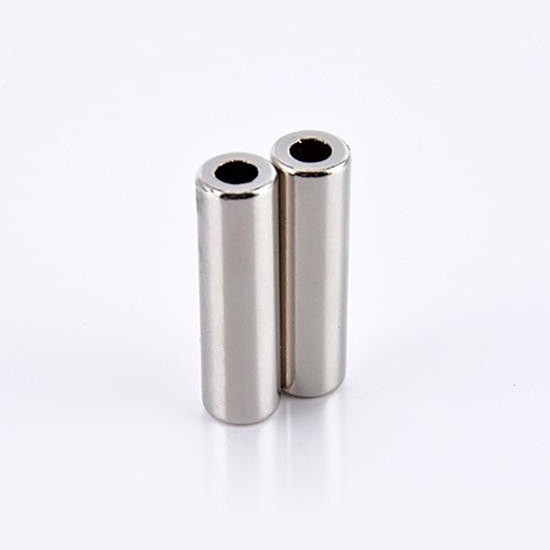How does the orientation of a cylindrical magnet in a magnetic field affect its behavior?
 Oct 31, 2025|
Oct 31, 2025| How does the orientation of a cylindrical magnet in a magnetic field affect its behavior?
As a supplier of cylindrical magnets, I've witnessed firsthand the diverse applications and behaviors of these remarkable magnetic components. Cylindrical magnets are widely used in various industries, from electronics and automotive to medical and renewable energy. One crucial factor that significantly influences their performance is the orientation of the magnet within a magnetic field. In this blog post, I'll delve into the science behind how the orientation of a cylindrical magnet affects its behavior and explore the practical implications for different applications.
Understanding Magnetic Fields and Cylindrical Magnets
Before we dive into the effects of orientation, let's briefly review the basics of magnetic fields and cylindrical magnets. A magnetic field is a region in space where a magnetic force can be detected. It is created by moving electric charges or by the intrinsic magnetic moments of elementary particles. Cylindrical magnets, as the name suggests, have a cylindrical shape and possess a north and a south pole. The magnetic field lines of a cylindrical magnet emerge from the north pole, curve around the magnet, and re - enter at the south pole.
The strength and direction of the magnetic field around a cylindrical magnet depend on several factors, including the magnet's material, size, and magnetization direction. The most common materials used for cylindrical magnets are neodymium, samarium - cobalt, and ferrite, each with its own unique magnetic properties.
Effects of Orientation on Magnetic Force
The orientation of a cylindrical magnet in an external magnetic field can have a profound impact on the magnetic force it experiences. When a cylindrical magnet is placed in a uniform magnetic field, the force acting on it can be calculated using the formula (F = m\times B\times\sin\theta), where (F) is the magnetic force, (m) is the magnetic moment of the magnet, (B) is the magnetic field strength, and (\theta) is the angle between the magnetic moment vector of the magnet and the direction of the external magnetic field.
- Parallel Orientation: When the magnetic moment of the cylindrical magnet is parallel to the external magnetic field ((\theta = 0^{\circ}) or (\theta = 180^{\circ})), the (\sin\theta) term in the force formula is either 0 (for (\theta = 0^{\circ})) or 0 (for (\theta = 180^{\circ})). In the case of (\theta = 0^{\circ}), the magnet is aligned with the external field, and there is no net translational force acting on it. However, there may be a torque that tries to keep the magnet in this stable alignment. When (\theta = 180^{\circ}), the magnet is anti - aligned with the external field, and there is a repulsive force acting on it.
- Perpendicular Orientation: When the magnetic moment of the cylindrical magnet is perpendicular to the external magnetic field ((\theta = 90^{\circ})), the (\sin\theta) term is equal to 1. This results in the maximum magnetic force acting on the magnet. The magnet will experience a force that tries to rotate it so that its magnetic moment aligns with the external field.
Effects on Magnetic Flux and Induction
The orientation of a cylindrical magnet also affects the magnetic flux passing through a given area and the induced electromotive force (EMF) in a nearby conductor. Magnetic flux ((\varPhi)) is defined as the product of the magnetic field strength (B), the area (A) through which the field passes, and the cosine of the angle (\alpha) between the magnetic field vector and the normal to the area ((\varPhi=B\times A\times\cos\alpha)).
- Optimal Flux Configuration: When the cylindrical magnet is oriented in such a way that the magnetic field lines are perpendicular to the area of interest, (\cos\alpha = 1), and the magnetic flux is maximized. This is important in applications such as magnetic sensors and generators, where a large magnetic flux change is required to induce a significant EMF. For example, in a simple generator, a rotating cylindrical magnet can be oriented to produce a maximum change in magnetic flux through a coil of wire, thereby generating a larger electrical current.
- Reduced Flux: If the magnet is oriented such that the magnetic field lines are parallel to the area of interest, (\cos\alpha = 0), and the magnetic flux through the area is zero. This can be useful in shielding applications, where minimizing the magnetic field in a particular region is desired.
Practical Applications and Considerations
The understanding of how the orientation of a cylindrical magnet affects its behavior is crucial in many practical applications.
- Motors and Actuators: In electric motors and actuators, the proper orientation of cylindrical magnets is essential for efficient operation. By carefully aligning the magnets, the magnetic forces can be optimized to produce the desired rotational or linear motion. For example, in a brushless DC motor, the cylindrical magnets in the rotor are oriented to interact with the magnetic field generated by the stator coils in the most efficient way, maximizing the torque and power output.
- Magnetic Separation: In magnetic separation processes, the orientation of cylindrical magnets can determine the effectiveness of separating magnetic particles from non - magnetic ones. By adjusting the orientation of the magnets, the magnetic force acting on the particles can be enhanced or reduced, depending on the specific requirements of the separation process.
- Magnetic Resonance Imaging (MRI): In MRI machines, cylindrical magnets are used to create a strong and uniform magnetic field. The orientation of these magnets must be precisely controlled to ensure accurate imaging. Any misalignment can lead to artifacts in the images and reduced diagnostic quality.
Our Product Offerings
As a supplier of cylindrical magnets, we offer a wide range of products to meet the diverse needs of our customers. Our Small Cylindrical Magnets are ideal for applications where space is limited, such as in micro - motors and electronic devices. These small magnets can be precisely oriented to fit into tight spaces while still providing the necessary magnetic performance.


Our Hollow Cylinder Magnets are designed for applications that require a magnetic field to pass through the center of the magnet. They are commonly used in magnetic bearings and some types of sensors.
For applications that demand long - term stability and high magnetic strength, our Cylindrical Permanent Magnet are an excellent choice. Made from high - quality materials, these magnets can maintain their magnetic properties over a long period, even in harsh environments.
Conclusion
The orientation of a cylindrical magnet in a magnetic field plays a critical role in determining its behavior, including the magnetic force it experiences, the magnetic flux it produces, and its performance in various applications. By understanding these effects, engineers and designers can optimize the use of cylindrical magnets in their products, leading to improved efficiency, reliability, and performance.
If you are in need of high - quality cylindrical magnets for your project, we are here to help. Our team of experts can assist you in selecting the right magnets and determining the optimal orientation for your specific application. Contact us today to discuss your requirements and start a fruitful procurement negotiation.
References
- Griffiths, D. J. (1999). Introduction to Electrodynamics (3rd ed.). Prentice Hall.
- Kittel, C. (2004). Introduction to Solid State Physics (8th ed.). Wiley.
- Purcell, E. M., & Morin, D. J. (2013). Electricity and Magnetism (3rd ed.). Cambridge University Press.

